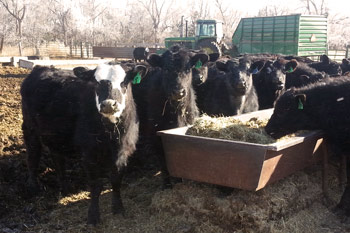News
Feedbunk Management: Advice From SDSU
 When it comes to the nutritional management of growing and finishing cattle, the scientific aspects tend to get the most attention. In truth, feeding cattle successfully is as much an art and judgment as science, explained Warren Rusche, SDSU Extension Cow/Calf Field Specialist.
When it comes to the nutritional management of growing and finishing cattle, the scientific aspects tend to get the most attention. In truth, feeding cattle successfully is as much an art and judgment as science, explained Warren Rusche, SDSU Extension Cow/Calf Field Specialist.
“Judgment is required to balance between over- and under-feeding. Under-feeding limits performance and possibly quality grade,” Rusche said. “While feeding too much increases feed waste, and more importantly, can trigger acidosis, poor performance and increased death loss.”
What does the research say?
Rusche pointed to a 1996 South Dakota State University research study conducted in which cattle fed all they would eat were compared to those fed just enough so that all the feed was consumed in a 24-hr period.
“They observed that steers fed with the slick bunk strategy had similar average daily gain (ADG) but improved feed efficiency compared to the steers fed to appetite,” Rusche said.
He added there was also more variation in ADG among steers fed all they would eat, suggesting that some steers may have experienced subclinical acidosis from over-consumption.
“The goal should be to achieve dry matter intakes as close as possible to the cattle’s appetite, while avoiding roller coaster intake patterns,” he said.
Dr. Robbi Pritchard at SDSU developed a widely-adopted scoring system to help cattle feeders minimize variation in feed intake and optimize performance.
“Tracking bunk scores and the amount of feed delivered helps identify pens that are right on track, those that should be offered more feed, and those that should be fed less,” he said. “Seeing bunk scores of 0.5 two or three days over a seven to 10 day-period, and scores of zero for the balance of that period, indicates a good balance between high intake to support performance, while minimizing inconsistencies in intake.”

Some guidelines for managing feed deliveries include:
- Feed calls should be made at the same time every day.
- Feed should be delivered at the same time every day, ideally within a 15-minute window.
- Do not increase feed offered by more than 5%.
- Feed should not be increased more frequently than every third day.
- Remove stale feed.
- Cattle behavior and aggressiveness in coming to the feed bunk can tell a great deal about whether or not feed deliveries should be increased.
Contact your local Pharmco team today for questions or help regarding feed bunk management, feeding rations and other issues related to your cattle operation!

